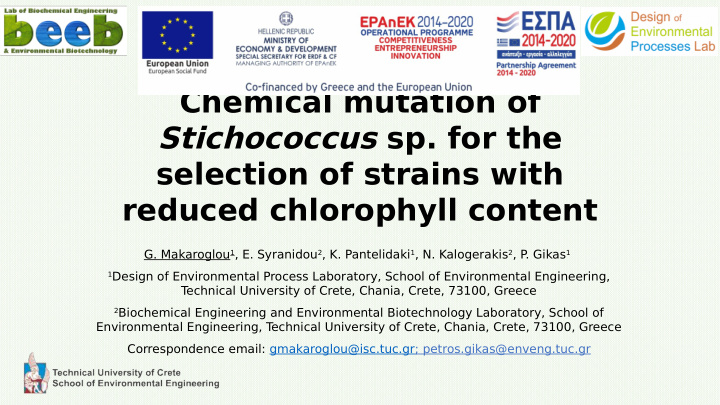



Chemical mutation of Stichococcus sp. for the selection of strains with reduced chlorophyll content G. Makaroglou 1 , E. Syranidou 2 , K. Pantelidaki 1 , N. Kalogerakis 2 , P . Gikas 1 1 Design of Environmental Process Laboratory, School of Environmental Engineering, T echnical University of Crete, Chania, Crete, 73100, Greece 2 Biochemical Engineering and Environmental Biotechnology Laboratory, School of Environmental Engineering, T echnical University of Crete, Chania, Crete, 73100, Greece Correspondence email: gmakaroglou@isc.tuc.gr; petros.gikas@enveng.tuc.gr
Microalgae • Unicellular photosynthetic microorganisms • Similar growth mechanisms as terrestrial plants, without having roots, shoots, stems or leaves • Require smaller cultivation areas • Growth parameters: Inorganic nutrients, CO 2 , Light, Water, pH, T emperature
Benefjts of Microalgae Sequester CO 2 Removal of from fmue gas of pollutants from electric wastewater powerplants
T ypes of photobioreactors CO 2 CO 2 CO 2
Microalgae and climate change Sunlight Closed Photobioreactor Bioproducts CO 2 as a carbon source
Bioproducts of microalgae Biopolymers Lipids Proteins Vitamins Carbohydrates Photosynthetic pigments Polyunsaturated Fatty acids
Selected strain • Stichococcus sp. strain was used throughout the experiments • It is a rod-shaped green microalgae • It is able to withstand extreme pH, temperature and salinity variations
Mutation methods Chemical Radiation Heavy ion (Ethyl Methyl (UV-, γ-, X- irradiation Sulphonate, rays) EMS)
Aim of the experiment • Reduced chlorophyll content decreases the “shadow efgect” in photobioreactors, allowing more light to penetrate into the culture • Mutant strains of Stichococcus sp. with reduced chlorophyll content and high biomass will be later cultivated in closed fmat photobioreactors, supplied with a combination of gasses (CO 2 , N 2 , O 2 , SO 2 , NO)
Cultivation of Stichococcus sp. • Culture medium: Experimental set Sterile Seawater + F/2 Medium (inorganic up nutrients, mainly 0.015 g/L NaNO 3 , trace metals, vitamins) • Treatments: Wild, EMS1, EMS3 with 0.015 g/L NaNO 3 Wild, EMS1, EMS3 with 0.75 g/L NaNO 3 • Illumination: 2x18 W warm-light fmuorescent lamps • T emperature: 23 o C • pH: 7.50 – 8.00
Mutation of Stichococcus sp. • EMS Concentrations: 1%, 1.25%, 1.5%, 1.75%, 2% with an objective to induce 95% lethality • Appropriate dilutions, plated in duplicates • Light green colonies cultivated for 3 generations to establish successful mutation
Biomass measurements Vacuum Filters fjltration system Wild EMS1 EMS3
Optical density, Photosynthetic Pigments measurements UV-Vis Spectrophotomete Spectrophotomete r cuvettes r Chlorophyll a (mg/l) = 16.72∙A665.2 - 9.16∙A652.4 Chlorophyll b (mg/l) = 34.09∙A652.4 - 15.28∙A665.2 Total Chlorophylls (mg/L) = Chl a +
Wild and Mutant strain in petri dishes Wild strain Mutant strain
Wild and Mutant strains Wild EMS1 EMS3
T otal Chlorophyll of Wild and Mutants 0,9 0,8 Strain Treatm ent otal Chlorophyll (μg/mg) 0,7 Wild With 0,6 0.75 g/L 0,5 NaNO 3 Wild 0,4 EMS1 With EMS1 0.015 EMS3 0,3 g/L 0,2 NaNO 3 T 0,1 EMS3 With 0 0.75 g/L 0.3 0.5 0.6 0.7 0.8 NaNO 3 Optical Density
Growth curves and biomass production of Wild and Mutants Days 1 9,5 Strain Treatm ent 0,9 9 Biomass dry basis (mg/mL) Wild With 0,8 0.75 g/L Biomass_Wild 8,5 0,7 Optical Density NaNO 3 Biomass_EMS1 0,6 Biomass_EMS3 8 EMS1 With OD_Wild 0,5 0.015 OD_EMS1 7,5 0,4 g/L OD_EMS3 NaNO 3 0,3 7 0,2 EMS3 With 6,5 0.75 g/L 0,1 NaNO 3 0 6 7 8 9 10 11 12 13
Conclusions • Mutant (EMS1) Stichococcus sp. has greater biomass production at a lower chlorophyll content • EMS1 seems to have great growth even though it does not have additional NaNO 3 • Stichococcus sp. is suitable for fmat photobioreactors due to its tendency to adhere to fmat surfaces, thus making it easier to extract
Future experimental set up
Thank you for your attention Correspondence email: gmakaroglou@isc.tuc.gr; petros.gikas@enveng.tuc.gr
Recommend
More recommend